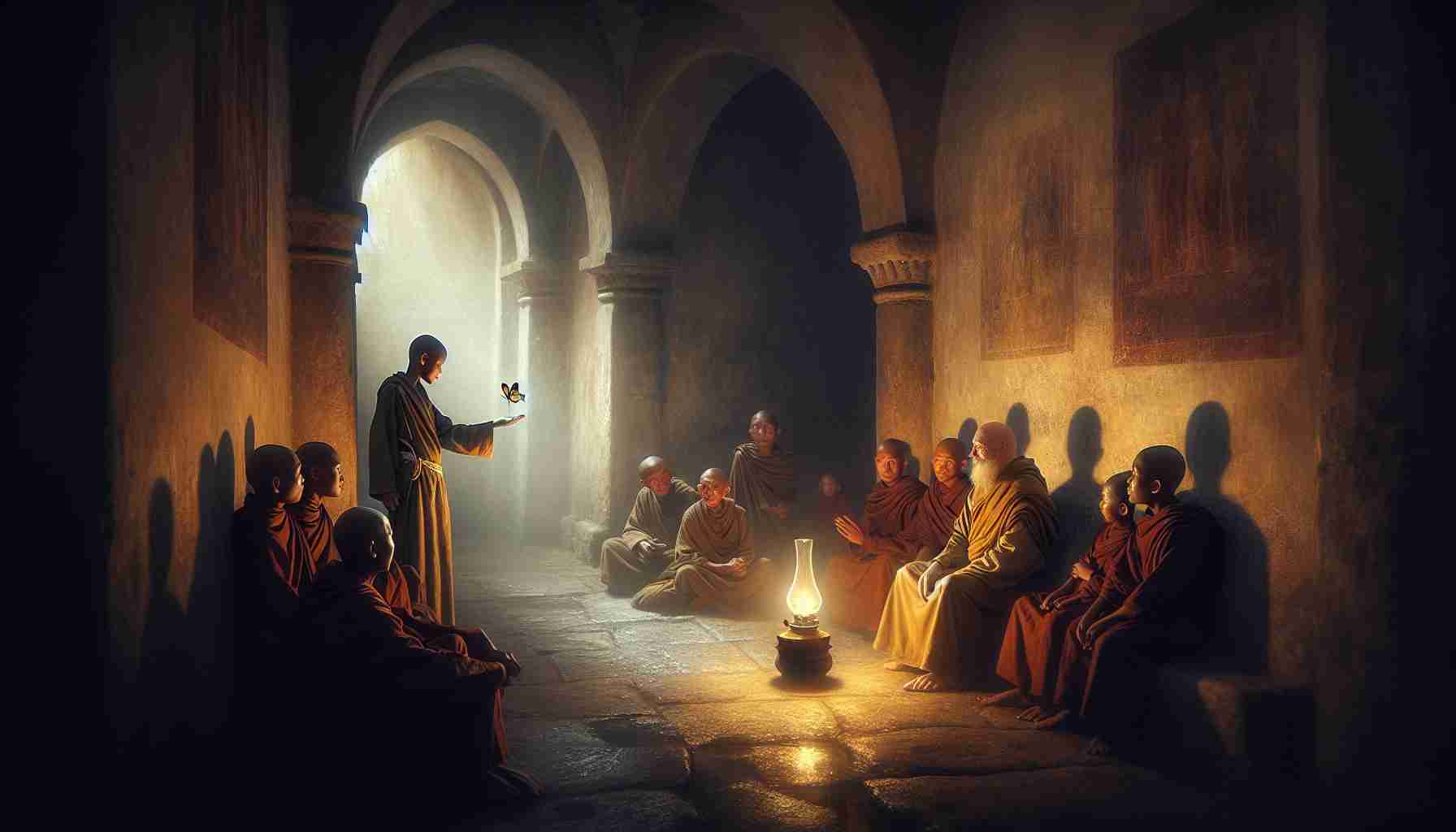

You won’t find my name in any scroll, but I once sat at the edge of the sangha—the community of monks—beneath the cool shade of the sal trees, listening to Buddha himself speak. I was just a servant boy, eleven summers old, carrying water and sweeping leaves for the forest monastery near Rajagaha, the capital of the Magadha kingdom.
I still remember the day the teaching came.
The sun had just set, and a small oil lamp had been lit in the hall. The room was quiet. Many bhikkhus—Buddhist monks—sat cross-legged, waiting, their robes as still as the air. I had settled in a corner, unseen, trying to hide my too-loud breathing. Suddenly, a soft fluttering sound broke the silence.
A butterfly.
It had crept inside, drawn by the flickering flame of the oil lamp. It circled above us once, then again, drifting lower with every turn, its wings dazzled by the dancing light.
The Buddha’s voice came, calm and deep like a river after monsoon rains.
“See how the butterfly chases the flame,” he said. Every head turned, watching the insect spiral again and again toward the fire. “It is filled with longing, craving for the radiance, not understanding the heat that lies beneath it.”
As if on cue, the butterfly dropped lower—and then it touched the flame.
A tiny sizzle. A puff of smoke. It fell, its wings turning to ash before reaching the ground.
I gasped before I could stop myself. My master, an old monk named Sarava, glanced back and gave me a small nod, telling me I wasn’t in trouble.
The Buddha continued, “This is the way of those lost in craving. Like the butterfly, the heart becomes trapped—drawn toward what dazzles, what promises sweetness and pleasure. But in chasing it, they burn. Again and again.”
He raised a hand, his palm open as if showing the world.
“To crave is to be caught. To let go is to be free.”
Later that night, I asked Sarava what the Buddha meant. The old monk smiled as we walked through the moonlit courtyard.
“It means,” he said gently, “that just like the butterfly, we too chase things—riches, praise, beauty, even fear and anger. These seem bright at first, but they consume us. Buddha teaches that by letting go of that hunger, that craving, the mind becomes still and clear.”
My young heart didn’t fully understand, but something deep inside me trembled at those words. Over the years, I watched more butterflies dance in lamps, but never again without remembering that evening.
Now, many years later, I sit beneath the same sal trees as a monk myself. I teach children and visitors about that night and the story of the butterfly.
Because in its small wings lies a great truth: when we stop reaching for the flame, just watching it flicker without clutching, we begin to understand peace. True peace. The peace of a heart that no longer burns, but rests.
You won’t find my name in any scroll, but I once sat at the edge of the sangha—the community of monks—beneath the cool shade of the sal trees, listening to Buddha himself speak. I was just a servant boy, eleven summers old, carrying water and sweeping leaves for the forest monastery near Rajagaha, the capital of the Magadha kingdom.
I still remember the day the teaching came.
The sun had just set, and a small oil lamp had been lit in the hall. The room was quiet. Many bhikkhus—Buddhist monks—sat cross-legged, waiting, their robes as still as the air. I had settled in a corner, unseen, trying to hide my too-loud breathing. Suddenly, a soft fluttering sound broke the silence.
A butterfly.
It had crept inside, drawn by the flickering flame of the oil lamp. It circled above us once, then again, drifting lower with every turn, its wings dazzled by the dancing light.
The Buddha’s voice came, calm and deep like a river after monsoon rains.
“See how the butterfly chases the flame,” he said. Every head turned, watching the insect spiral again and again toward the fire. “It is filled with longing, craving for the radiance, not understanding the heat that lies beneath it.”
As if on cue, the butterfly dropped lower—and then it touched the flame.
A tiny sizzle. A puff of smoke. It fell, its wings turning to ash before reaching the ground.
I gasped before I could stop myself. My master, an old monk named Sarava, glanced back and gave me a small nod, telling me I wasn’t in trouble.
The Buddha continued, “This is the way of those lost in craving. Like the butterfly, the heart becomes trapped—drawn toward what dazzles, what promises sweetness and pleasure. But in chasing it, they burn. Again and again.”
He raised a hand, his palm open as if showing the world.
“To crave is to be caught. To let go is to be free.”
Later that night, I asked Sarava what the Buddha meant. The old monk smiled as we walked through the moonlit courtyard.
“It means,” he said gently, “that just like the butterfly, we too chase things—riches, praise, beauty, even fear and anger. These seem bright at first, but they consume us. Buddha teaches that by letting go of that hunger, that craving, the mind becomes still and clear.”
My young heart didn’t fully understand, but something deep inside me trembled at those words. Over the years, I watched more butterflies dance in lamps, but never again without remembering that evening.
Now, many years later, I sit beneath the same sal trees as a monk myself. I teach children and visitors about that night and the story of the butterfly.
Because in its small wings lies a great truth: when we stop reaching for the flame, just watching it flicker without clutching, we begin to understand peace. True peace. The peace of a heart that no longer burns, but rests.